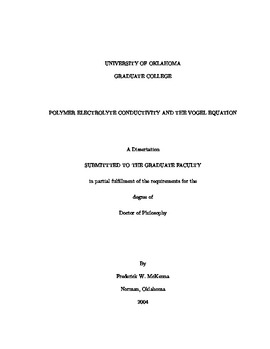| dc.contributor.advisor | Furneaux, John E., | en_US |
| dc.contributor.author | Mckenna, Frederick W. | en_US |
| dc.date.accessioned | 2013-08-16T12:19:34Z | |
| dc.date.available | 2013-08-16T12:19:34Z | |
| dc.date.issued | 2004 | en_US |
| dc.identifier.uri | https://hdl.handle.net/11244/806 | |
| dc.description.abstract | The frequency-dependent conductivity of an amorphous polymer electrolyte is examined. It is shown that the frequency-dependent conductivity of polymer electrolytes exhibit many of the same properties as ion conducting glasses. This suggests similarities in the mechanism of ion conduction between polymer electrolytes and ionic glasses. | en_US |
| dc.description.abstract | The free volume theory of the Vogel equation is discussed. Some of the weaknesses of this theory as applied to polymer electrolytes are pointed out. A theory of the Vogel equation in terms of hopping models is presented. This theory is consistent with the results of the frequency-dependent conductivity and semi-crystalline polymer electrolytes. | en_US |
| dc.description.abstract | The conductivity of semi-crystalline polymer electrolyte systems are also investigated. This work demonstrates that at least two separate ion conduction mechanisms are occuring in semi-crystalline polymer electrolytes. A proposal is made for understanding the discontinuities seen in the conductivity of semi-crystalline polymer electrolytes. | en_US |
| dc.description.abstract | Polymer electrolytes are ion conducting solids with possible applications to rechargeable batteries. Despite great interest much remains unknown about the conductivity of polymer electrolytes. A number of topics concerned with polymer electrolyte conductivity are discussed in this work. | en_US |
| dc.description.abstract | An examination of conductivity prefactors revels the possible presence of the compensation effect. While great care must be taken before reporting a compensation effect, this work and the work of other researchers suggests that there is relation be tween the conductivity prefactors and the activation energy. Various theories of the compensation effect are discussed, and consistent with Linert's theory a connection is made between the compensation effect and the vibrational spectra of the polymer. | en_US |
| dc.format.extent | x, 200 leaves : | en_US |
| dc.subject | Physics, Condensed Matter. | en_US |
| dc.subject | Electrolytes Conductivity. | en_US |
| dc.subject | Polyelectrolytes. | en_US |
| dc.title | Polymer electrolyte conductivity and the Vogel equation. | en_US |
| dc.type | Thesis | en_US |
| dc.thesis.degree | Ph.D. | en_US |
| dc.thesis.degreeDiscipline | Homer L. Dodge Department of Physics and Astronomy | en_US |
| dc.note | Adviser: John E. Furneaux. | en_US |
| dc.note | Source: Dissertation Abstracts International, Volume: 65-09, Section: B, page: 4630. | en_US |
| ou.identifier | (UMI)AAI3148979 | en_US |
| ou.group | College of Arts and Sciences::Homer L. Dodge Department of Physics and Astronomy | |
